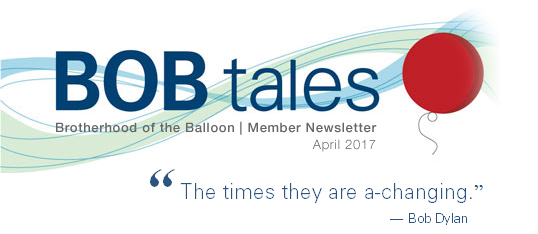
Dear Members:
We are blessed to have truly interested and interactive members in our group. Our BOB Tales newsletter goes out to thousands of our members plus about 500 others. Deb Hickey routinely hears from hundreds of members after each issue is published and we love that. We have been informed by our email distributor, Constant Contact, our open- and click-through rates are 300 percent higher than their 700,000 customer base. That tells us our readers are interested in the content of our newsletter. Many have told us they forward the BOB Tales to family members, friends, and acquaintances. We encourage you to do the same if you think others would benefit from reading specific articles.
We have lots to report this month. New and important developments in prostate cancer prevention, diagnosis, and treatment seem to be happening almost daily. Similarly, new and important things are happening in the proton world at an accelerating rate. The BOB Tales would be 100 pages long if we attempted to report all of these issues. So we attempt to relay the most significant happenings by abstracting articles that come to us from dozens of sources, and provide links to more information so readers can find details on a story that particularly interests them.
This month we report on several significant issues on prostate cancer and proton therapy. To name a few:
- There is more evidence that advanced technology image-guided biopsies are obsoleting the current 30-year-old “blind biopsy” procedures most urologists perform today, resulting in more accurate prostate cancer detection and a reduction in unnecessary biopsies. This has huge implications.
- More studies confirm the importance of maintaining proper vitamin D levels to aid in the prevention of prostate cancer as well as the prevention of more aggressive forms of the disease.
- One of the most prominent prostate cancer experts devoted an entire newsletter to the subject of statin drugs, cardiovascular disease, and prostate cancer. His conclusions with regard to the benefit of statins to preventing prostate cancer, prostate cancer recurrences, and aggressive prostate cancers will astonish you.
- A recent study confirms the important role that components found in one of the safest and oldest drugs on the planet can play in preventing many cancers.
- A study at Loma Linda University involving 26,000 men has shown that a specific diet change can have a dramatic impact on preventing prostate cancer.
- Three years after his parents were jailed for removing him from the hospital and taking him out of the UK for treatment, a little boy is cancer free, thanks to proton therapy.
- More proton centers are being built around the world, including the first proton center in Alabama.
As Deb reported last month, I was honored to have been asked to participate in a project to plan and conduct a comprehensive, prospective study comparing proton therapy to IMRT for treating prostate cancer. A study of this kind has never been done and would answer many questions that are of critical importance to physicians and especially patients, who are being denied proton therapy because of cost and lack of scientific evidence it is superior to other forms of radiation therapy.
The project was kicked off with a workshop in Jacksonville, FL, with more than 50 in attendance, mostly representatives from 16 U.S. proton centers. The project is headed-up by University of Florida Health Proton Therapy Institute Medical Director, Dr. Nancy Mendenhall, a physician with considerable passion for this project as well as the energy and drive to see it through. After the workshop, a letter of intent (LOI) was drafted and sent to the Patient-Centered Outcomes Research Institute (PCORI) requesting funding. The LOI is comprehensive and inclusive. If funding is approved, the study would ramp up over the next year. If/when the LOI is accepted, we will provide details on the scope, magnitude and duration of this critically important study. Stay tuned.
As I write this memo, Deb and I are preparing travel to Orlando, FL to attend the annual National Proton Conference (NPC). This is a three-and-a-half day gathering of all the key players in the proton world including clinicians, physicists, scientists, administrators, and vendors. There will be presentations and workshops on subjects including the evolution of proton therapy, planning and developing a proton center, dealing with insurance and reimbursement challenges, best practices, proton accelerators and proton therapy of the future, and much more. A large exhibition hall will display the latest technologies in proton therapy and related equipment and systems. This will be my fourth NPC (Deb’s first) and, as in the past, I’m as excited as a kid visiting Disney World. I learn a lot from the conferences and always spend a lot of time in the exhibition hall. Deb and I will be providing details of NPC in our next BOB Tales.
We hope you enjoy the April issue. As always, we welcome and encourage feedback. Just send an email to [email protected].
Bob Marckini
To print the BOB Tales newsletter or view the newsletter with a larger font size, click here for the PDF file.
In This Issue:
- MRI Improves Prostate Cancer Diagnosis
- Statins and Prostate Cancer: Startling New Information
- Insufficient Vitamin D Levels Related to More Aggressive Prostate Cancers
- More Evidence Aspirin Helps Prevent Cancer
- Slash Risk of Prostate Cancer by 35 Percent
- BOB Member and Wife Treated with Protons at the Same Time
- $74,000 to Marckini Chair in December
.jpg)
MRI Improves Prostate Cancer Diagnosis
We have written about this before in the BOB Tales, and the data continue to pour in confirming that new technologies are greatly improving doctors’ abilities to diagnose prostate cancer as well as saving the patient unnecessary biopsies and some of the resulting side effects.
A new trial by Medical Research Council (MRC) at UCL has shown that over a quarter of men with a clinical suspicion of prostate cancer could avoid an invasive biopsy if they undergo a multi-parametric MRI (mp-MRI) scan first.
Also, the detection of aggressive cancers can be almost doubled by doing an mp-MRI. If the scan is suspicious, the mp-MRI can give information about where the cancer is and its size.
Typical prostate biopsies are invasive procedures that can sometimes lead to side effects such as pain, bleeding, erectile dysfunction, and infection. They can also be inaccurate because they typically sample only random areas of the prostate. Most prostate biopsies are done by this 30-year-old technology, often referred to as a “blind biopsy.”
 Latest technology mp-MRIs can often identify men who might safely avoid a biopsy and consider active surveillance. This MRI technology can also tell the doctor where suspicious lesions are that should be targeted by biopsy.
Latest technology mp-MRIs can often identify men who might safely avoid a biopsy and consider active surveillance. This MRI technology can also tell the doctor where suspicious lesions are that should be targeted by biopsy.
Multi-parametric MRIs detected 93 percent of clinically important cancers in a study that involved 576 men with suspected prostate cancer.
Statins and Prostate Cancer: Startling New Information
Statins are cholesterol-lowering drugs like Atorvastatin, Simvastatin, Rosuvastatin, Pravastatin, and Lovastatin. More recognizable common names of these drugs are Lipitor, Zocor, Crestor, Pravacol, and Mevacor.
Dr. Charles “Snuffy” Myers, world-renowned prostate cancer treatment expert and prostate cancer survivor, publishes a monthly newsletter, Prostatepedia. His latest issue, Volume 2, No. 6, February 2017, devoted much attention to cardiovascular disease, statins, and prostate cancer.
Cardiovascular Risk
Myers feels that physicians who treat aggressive prostate cancer are often poorly informed about cardiovascular risk management and commonly ignore it. He also criticizes internet sites for distorted and misinformation on the toxicity of statin drugs, which Myers feels are one of the safest drug families.
Dr. Michael Freeman, director of the Division of Cancer Biology and Therapeutics Research and the Division of Basic Science Research at Cedars-Sinai in Los Angeles, was interviewed for the February issue of Prostatepedia. Dr. Freeman spends much of his time studying prostate cancer progression.
Cholesterol Levels and Prostate Cancer
One of his findings is that cholesterol is a risk factor
for prostate cancer, and that high cholesterol is a risk factor for aggressive prostate cancer. He believes there is emerging consensus from epidemiologic studies that lowering levels of cholesterol has a protective effect against aggressive forms of prostate cancer, but probably not for prostate cancers that progress slowly or would not be clinically relevant during a patient’s lifetime. However, he feels that “epidemiologic data showing that long-term statin therapy can reduce the likelihood of aggressive prostate cancer is pretty strong.”
Statins and Prostate Cancer Recurrence
Dr. Freeman further believes that statins could help prevent a recurrence in patients who have already been treated for prostate cancer. “Statins are considered very safe drugs,” he said. “The primary side effects are muscle pain, but most people are not susceptible to that … I don’t think there is any reason not to go on a statin if a patient and his physician are concerned about a risk of prostate cancer.”
Statins and Aggressive Prostate Cancer
Dr. Alison Mondul, assistant professor of Epidemiology at the University of Michigan in Ann Arbor, was also interviewed for this issue of Prostatepedia. She had this to say: “Higher cholesterol seems to be associated with higher risk of more aggressive prostate cancer, or prostate cancer with a worse prognosis.” She noted that several studies have seen a higher risk of high-grade disease with higher levels of cholesterol, and she believes that by lowering cholesterol levels, statins can protect against more aggressive prostate cancer.
“Statins do other things that may also be protective,” says Dr. Mondul. “They are anti-inflammatory. They act through other pathways that may also have an important role in preventing more progressive disease.”
She believes there is no downside to reducing cholesterol levels. Further, she believes that taking statins prior to diagnosis may help prevent aggressive disease, and taking statins after diagnosis may help prevent death.
Another expert in the field is Dr. Hyung Kim, a urologic oncologist at Cedars-Sinai. He too feels that “statin use will improve your likelihood of surviving the disease.”
The benefits of taking statins to prevent aggressive prostate cancer and/or a recurrence seem to be overwhelming. You may want to discuss this subject with your doctor. You also may want to share this information with family members and friends who are at risk for prostate cancer.
Insufficient Vitamin D Levels Related to More Aggressive Prostate Cancers
We have written about the importance of maintaining proper levels of vitamin D to help prevent prostate cancer or a prostate cancer recurrence. Recently Northwestern University conducted a study to determine the association between insufficient vitamin D levels and aggressive prostate cancer (J Clin. Oncol. 2016 Feb 22).
The study involved 1,760 men, 190 of whom had undergone radical prostatectomies. Blood samples collected prior to surgery were analyzed for serum 25-hydroxyvitamin D. Eighty-seven of the men had indications of aggressive disease at the time of their surgeries. Insufficient vitamin D levels (less than 30 ng/mL) were associated with a 2.64 times greater risk of adverse pathology compared with higher levels of the vitamin.
Doctors consider the optimal vitamin D level to be 50 – 70 ng/ml, and in some cases when treating certain cancers or heart disease, as high as 70 – 100 ng/mL.
As we have reported in the past, not all vitamins and supplements are absorbed by the body equally. You should always buy high quality brands and discuss their use with your physician.
 More Evidence That Aspirin Helps Prevent Cancer
More Evidence That Aspirin Helps Prevent Cancer
Scientists from the Gladstone Institutes in San Francisco identified a new mechanism by which aspirin could fight inflammation and cancer. The study was published in eLife (May 31, 2016) and was reported in Life Extension Magazine.
Researchers discovered that salicylic acid, a major compound in aspirin and diflunisal, an analgesic that’s derived from salicylic acid, suppresses two key proteins that control inflammation, cell growth and cancer.
“Salicylic acid is one of the oldest drugs on the planet, dating back to the Egyptians and the Greeks, but we’re still discovering new things about it,” said senior author Eric Verdin, MD.
Slash Risk of Prostate Cancer by 35 Percent
Ditching meat could dramatically cut your odds of developing cancer by more than a third. Scientists at Loma Linda University analyzed the diets of 26,000 men including meat-eaters, pescatarians and vegans. They learned that adopting a vegan diet—consuming no meat, dairy, and eggs—can slash your likelihood of developing prostate cancer by a whopping 35 percent.
Dr Panagiota Mitrou, director of research funding at World Cancer Research Fund, said, “This exciting research has, for the first time, helped fill some vital gaps in our knowledge about eating patterns and the prevention of prostate cancer and could pave the way for future research. Although these results are exciting, more studies are needed to demonstrate the strength of the link between a vegan diet and reducing the risk of prostate cancer.”
Professor Gary Fraser, study researcher at Loma Linda University, added, “This new research makes a significant step in linking a vegan diet to reduced prostate cancer risk. What we now need is more research into this area to determine to the extent a vegan diet could reduce the number of men developing this cancer.”

BOB Member and Wife Treated with Protons at the Same Time
“Bob Marckini’s book and my experience at Loma Linda University Cancer Center changed my life and the life of my wife, Glenis, forever,” said BOB member, James Pennington (Towanda, KS).
James discovered Bob’s book, You Can Beat Prostate Cancer: And You Don’t Need Surgery To Do It, online during intensive research after receiving his prostate cancer diagnosis in 2011. “Bob’s engineer’s approach and complete explanations convinced me to go to LLUCC for a consultation. While there, I made my decision—proton therapy was the best treatment option for me.”
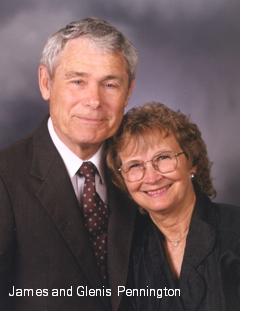 During treatment, James learned how to choose healthful foods; how to cook; and how to exercise to maintain optimal health. Incidentally, he also learned about clinical trials going on at the hospital. In particular, there was a proton therapy clinical trial for breast cancer. Shortly after his prostate cancer diagnosis, James’ wife, Glenis, was diagnosed with breast cancer. On the last day of James’ 45 proton treatments, Glenis began the first of 10 proton treatments for breast cancer.
During treatment, James learned how to choose healthful foods; how to cook; and how to exercise to maintain optimal health. Incidentally, he also learned about clinical trials going on at the hospital. In particular, there was a proton therapy clinical trial for breast cancer. Shortly after his prostate cancer diagnosis, James’ wife, Glenis, was diagnosed with breast cancer. On the last day of James’ 45 proton treatments, Glenis began the first of 10 proton treatments for breast cancer.
“After Glenis’ treatment ended, we flew home on Thanksgiving day,” James told us. “Our holiday dinner was a tuna sandwich.” But that didn’t matter to James, “Thanks to Bob Marckini and LLUCC, five years later, we seldom think about cancer.”
James and Glenis may be the only couple to receive proton therapy at the same time. And James told us they’ve never looked back.
Member Feedback
BOB member Dave Vahlsing (Wynnewood, PA) sends copies of the BOB Tales newsletter, every month, to more than 35 friends and acquaintances, including his primary care physician. When forwarding the newsletter to friends, Dave typically writes an introductory note, summarizing the key points of the newsletter, hoping to stimulate interest in opening, clicking through, and reading the entire newsletter.
Here’s the introductory note Dave sent to friends with our February newsletter:
Folks: The attached BOB Tales newsletter addresses the importance of understanding the role of stress on interfering with your immune system’s ability to ward off growth of bad cells. Most of you have been following the amazing development in technology to remove, boost and reinsert your own guardian cells so they can go after cancers. If we can help our system do this with the measures discussed in the most recent newsletter, why not?
As usual, I offer to remove you from my email list that currently gets these newsletters, if they are not helpful to you.
I started my treatment at Loma Linda University Cancer Center on January 17, 2007—10 years ago! Everything is going very well for me. I’m a very fortunate person to have discovered this treatment option and to have enjoyed, yes enjoyed, the service provided by this wonderful institution. Good health to all. —Dave
.gif)
We have been producing BOB Tales newsletters monthly for 16 years. There have been important articles that new members have not seen, and others may have forgotten. We are periodically re-running some articles from past newsletters. The following is from May 2003.
Don’t Worry; Be Happy!
I was reading our local newspaper recently and saw an article titled, “Don’t Worry; Be Happy.” The subtitle was: “Sunny people have brighter outlook, stay healthier.” It was about achieving a balance among the physical, emotional, and spiritual elements in your life. If you can do that, chances are excellent that your physical health will improve right along with your emotional well-being.
Happiness isn’t just a touchy-feely concept—it’s being studied by health experts worldwide for its possible link to better physical health. Later in the article the reporter commented that this study was based on work under way at the University of California at Irvine and, you guessed it, Loma Linda University School of Medicine. The article also noted that the study involved showing people a one-hour humorous video and then observed a decrease in production of stress hormones that could last 12 to 24 hours. That explains some of the jokes, poems, songs, and antics from our friends Gerry Troy and Dr. Lynn Martell at the Wednesday night support group meetings.
So, don’t worry, be happy!

Loma Linda Comes to You: Dayton, OH
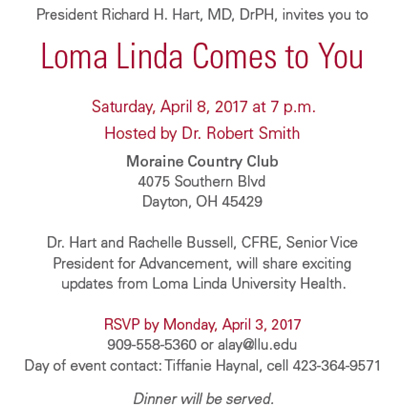
BOB Reunion: Portland, OR
Thursday, May 25, 2017: Golf and dinner. More information will follow in the May issue of BOB Tales.

$74,000 to Marckini Chair in December
In December, 48 BOB members made gifts to the Robert J. Marckini Chair for Proton Therapy Research at Loma Linda University Cancer Center. The average gift amount was $1,540 and the total was $73,931.
“Nothing makes me happier than to see gifts being made to the chair bearing my name,” Bob said. “When I think of all the important proton research projects needing funding, it warms my heart to see these contributions coming in.”
The Robert J. Marckini Endowed Chair for Proton Therapy Research, an outgrowth of the BOB Chair Fund, was established in 2013 through a generous gift from BOB member, Chuck Kubicki. Since that time, members have regularly contributed to the chair, often in honor of Bob Marckini or care givers at LLUCC. The chair is approaching $3 million and is helping to fund proton research at Loma Linda University Cancer Center.
Bob wants to convey his heartfelt thanks to all who have contributed, and wants to encourage our members to remember the Marckini Chair and Vision 2020 in your charitable giving and estate planning.
 How to Contribute to Proton Research
How to Contribute to Proton Research
- Donate Online: Visit the LLUCC website. Make sure the “Designation Type” is set to “Proton” and the “Designation” is set to “Robert J. Marckini Chair."
- Send a Check: Make your check out to “LLUCC Proton” with “Marckini Chair” on the memo line and send to: LLUH, Office of Philanthropy, P.O. Box 2000, Loma Linda, CA 92354.
- Make a Call: Contribute by phone. Contact Elvia DeHaro at 909-558-5010
- Make a Future Gift: Contact Todd Mekelburg at the Office of Planned Giving at Loma Linda University Health at 909-558-5376 or [email protected].
- Other Ways to Give: Contact Matt Miller at the Office of Philanthropy at Loma Linda University Health at 909-558-3582 or [email protected].

Regular Dental Cleanings Lower Pneumonia Risk
Odd as it seems, it’s true, according to Michelle Doll, MD, MPH, assistant professor and associate hospital epidemiologist in the department of internal medicine, division of infectious diseases, Virginia Commonwealth University School of Medicine.
In a study of more than 26,000 people, those who did not go to the dentist were 86 percent more likely to get bacterial pneumonia than those who had dental checkups twice a year. Regular dental cleanings reduce levels of bacteria that cause lung infection.
The Dirtiest Spot on an Airplane: NOT the Toilet!
A microbiologist hired by Travelmath came up with the following dirtiest places on an airplane:
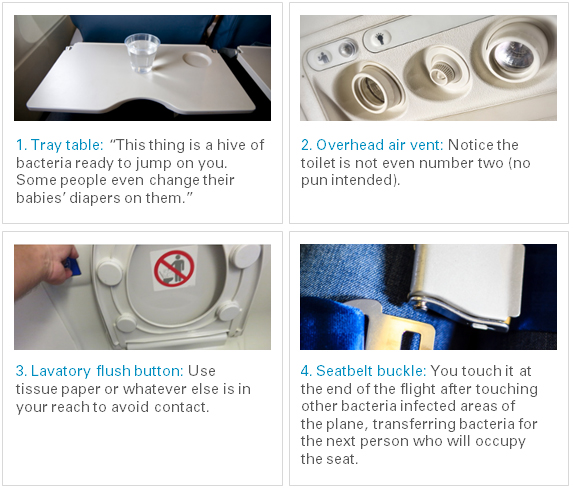
It’s always a good idea to travel with disinfecting wipes and to wipe-down your seat, tray table, overhead air vent, seatbelt buckle, etc.
Series: “Make Vegetables Taste Good”
This is the eighth segment on a subject that’s consistent with our Anticancer series that began in October 2016. Deb Hickey made it her mission to find recipes that make the most healthful vegetables taste delicious. She also learned that some vegetables fight specific health issues while others interact with each other to become “super” foods that target specific cancers.
We hadn’t received much feedback on this series, so last month we asked readers to let us know if they find this section valuable. Not only were we overwhelmed with emails asking us to continue the series; several of you sent recipes and some emailed tips and tricks for cooking healthfully. Thank you! We will continue posting vegetable-based recipes and invite readers to send us their recipes.
Black Bean Brownies
The following recipe was sent in by a BOB member last month. He told us, “Finding good vegetarian recipes isn’t easy,” (especially when it comes to dessert!) and attached a few that he and his wife have enjoyed. The following is from the Food Network.
Time: 50 mins
Ingredients:
- Butter for greasing pan
- ¾ cup cooked black beans
- ½ cup vegetable oil or olive oil
- 2 eggs
- 1/3 cup unsweetened cocoa powder
- 2/3 cup sugar
- 1 tsp. instant coffee or espresso
- 1 tsp. vanilla extract
- ½ cup mini chocolate chips, divided
- 1/3 cup flour
- ½ tsp. baking powder
- ½ tsp. salt
- ¼ cup confectioners’ sugar for dusting (optional)
Directions:
Preheat oven to 350 degrees F. Grease 9x9-inch square baking pan. In a blender, puree the beans with oil. Add eggs, cocoa, sugar, coffee, and vanilla. Melt half the chocolate chips and add to blender. Blend on medium-high until smooth. In small bowl, whisk flour, baking powder, and salt. Add to blender and pulse until incorporated. Stir in remaining chocolate chips. Pour into pan. Bake about 20 minutes (surface should look somewhat matte around edges and shiny in the middle). Let cool 15 minutes and dust with confectioners’ sugar.

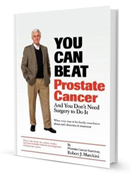
Amazon: Surge in Reviews after Last Month’s Newsletter—Thank You!
Last month, we reported that Amazon reviews for Dr. Patrick Walsh’s book, Surviving Prostate Cancer, had doubled (to 467) in one week. For years, Bob Marckini’s book, You Can Beat Prostate Cancer, had more reviews than any other prostate cancer-related book in the top 50 Amazon search results. We are not sure how the number of reviews for Dr. Walsh’s book jumped so dramatically; we suspect there was something strange going on.
Last month, we asked our members (and other newsletter readers) who have read Bob Marckini’s book—even if they had read it years ago—to post a review on Amazon as we need them now more than ever. As a result, there were a record number of reviews posted last month (total is now 302). Thank you!
Please keep them coming! Post a review today. Below are excerpts from recent reviews:

This is a ‘must read’ book.
… I decided to buy this book based on the title … I am in the process of making arrangements to go to Loma Linda for a consultation, as this facility has been online the longest, since 1990, despite my living across the country in VA. Even though the book was written 10 years ago, the information in it is still valid… —George Gilmer, 2/22/17

Save Your Life—Read This Book
I read this book 10 years ago … It clearly and logically presents evidence about alternative treatment options that enables the reader to see the benefit of proton therapy … I used what I learned from the author, who is also a cancer survivor, and have remained cancer free with no adverse side effects. —AFK/MCK, 2/17/17

Proton Therapy—the real 'GOLD STANDARD'
7 years ago I had a PSA of 18 and was a Gleason 7. I was told by three different doctors there were options but the “gold standard” was surgery, preferably robotic … a friend told me about his son-in-law’s successful proton treatment at Loma Linda University in southern California. I called him … after a glowing endorsement he , in turn, gave me another man’s number to call. He also gave a similar success story and told me to read Bob Marckini’s book … I made the decision and it was one of the best of my life. It truly was like a weight lifted from my heart and shoulders … Side effects from radiation? ABSOLUTELY NONE! No incontinency, no impotency, no more cancer! —Bruce Helm, 2/17/17
Buy Online, in Bulk or in Spanish
Online: Paperback: $19.00--•--Kindle: $9.99--•--NOOK Book: $9.99--•--Apple iBook: $9.99
In Bulk: Conctact us for a discount price list. Proceeds from book sales support proton therapy research through the Robert J. Marckini Endowed Chair at LLUCC.
In Spanish: Buy the print version or in eBook format.

Interesting Q&A
How many gallons of gasoline does one (decomposed) dinosaur make?
Contrary to popular belief: None. Oil was created from organisms that lived long before dinosaurs roamed the earth. Back then, the planet was warmer and the seas were filled with one-cell organisms. This matter was buried as the oceans and rivers dried up; the material was “cooked” into oil and natural gas. The dinosaur connection became popular back in 1930 when an oil company adopted a dinosaur trademark.
When is a can of food too old to use?
A can of food left by Sir John Franklin in the Arctic was found to still be edible 94 years later, in 1939. However, we still suggest you pay attention to the expiration date!
What jobs are most endangered?
According to CareerCast, the 10 most endangered jobs are mail carrier, typist/word processor, meter reader, disc jockey, jeweler, insurance underwriter, seamstress/tailor, broadcaster, newspaper reporter, and computer programmer.
What are the seven best jobs for 2017?
According to Monster.com, most are in the medical field: dentist, nurse practitioner, physician assistant, statistician, orthodontist, nurse anesthetist, and pediatrician.
Trivia
- What is the highest point in the world?
- What is the lowest point in the world?
- What is the most photographed place in the U.S.?
- Where is the wettest spot on earth? (And it’s not the Amazon)
- Where is the driest spot on earth? (It’s not the Sahara)
- Which country consumes the most food per capita?
Estate Planning Hints
BOB member Ron Hendricks is director of gift planning for Trinity Western University. He regularly copies us on his “News from Ron” mailings, which are helpful hints on estate planning to the readers of his newsletters. We have found Ron’s suggestions to be timely and beneficial. With his permission we periodically share some of his wisdom with our membership. This segment is called Planning for Probate.
Planning for Probate
How can you avoid probate? Generally, most individuals can avoid probate for a large portion of their assets. The probate process is important because when a person passes away; his or her property must first be used to pay bills, expenses and debts. An executor or personal representative is appointed to gather an inventory of all assets, conserve assets for all beneficiaries and make certain to carry out the decedent's intentions as written in his or her will.
The probate process specifically applies to assets transferred under your will. However, many types of assets are transferred through other means. Trusts, IRAs and insurance are subject to the terms of the agreement or beneficiary designation. Property held in joint tenancy with right of survivorship is transferred to the survivor whose name is on title. Transfer upon death, pay-on-death and other types of accounts can avoid probate. However, all parts of your entire plan need to work together. When a plan has not been carefully developed to meet your goals, there may be an expensive and heart-rending fight over property by your heirs. A good plan will give one of the best possible gifts
to your family—the gift of peace.
Wills and Trusts
Do you have a will? It may not be current if you have not looked at in the past five years. You should review your will periodically and discuss your plan with your attorney. If you have a substantial estate, a will with a trust may be appropriate. Because a will does not provide for your care in a medical emergency, you will want to make sure that your estate planning includes a will, a durable power of attorney for healthcare and a living will to handle end-of-life issues.


Last Month’s Brain Teaser
There are two bugs in a gallon jar. Every minute, the number of bugs doubles. If the jar is filled in half an hour, how long is it before the jar is only half filled?
Answer: The answer is 29 minutes. If the jar—no matter what its size—is filled in 30 minutes, and if the number of bugs doubles every minute, there would be only half as many bugs one minute before that.
 Winner: The winner of last month’s brain teaser is Victor Berthelsdorf (McMinnville, OR). Victor is another member who, after diagnosis, learned about proton therapy from researching online and finding Bob Marckini’s book, You Can Beat Prostate Cancer. “I was scheduled for surgery,” Victor told us. “I will forever be grateful I came across that book.”
Winner: The winner of last month’s brain teaser is Victor Berthelsdorf (McMinnville, OR). Victor is another member who, after diagnosis, learned about proton therapy from researching online and finding Bob Marckini’s book, You Can Beat Prostate Cancer. “I was scheduled for surgery,” Victor told us. “I will forever be grateful I came across that book.”
Victor refers to his proton therapy at Loma Linda University Cancer Center this past August as “pretty uneventful.”
Victor keeps himself very busy. After a career in leaded and stained glass based in Lutz, FL, Victor retired to Oregon and enjoys many hobbies. He’s built an experimental airplane; restored a 1940’s Aeronca 11ac Scout (single-engine, two-seat light aircraft); and picked up a glider pilot rating. He’s also interested in macro photography—view some of his photos here—and lives on 571 acres that he recently turned into a wildlife preserve.
New Brain Teaser
Who is this man?
- As a wrestler, he lost only one of his 300 matches.
- He was a licensed bartender.
- He never graduated from college. In fact, he had less than a year of formal schooling.
- He hated his nickname.
- His mother was poisoned when he was 9 years old.
- He was the tallest person ever to have the job he had, and he wore size 14 shoes.
- He suffered from depression.
- His wife was an opium addict.
- His “hobby” was … cats.
As always, send your brain teaser answer to [email protected] for a chance to win a signed copy of Bob Marckini’s book, You Can Beat Prostate Cancer.
Memory Problems
A couple in their nineties is having problems remembering things. During a check-up, the doctor tells them that they’re physically okay, but they might want to start writing things down to help them remember.
Later that night, while watching TV, the old man gets up from his chair. “Want anything while I’m in the kitchen?” He asks his wife.
“Will you get me a bowl of ice cream?”
“Sure.”
“Don’t you think you should write it down so you can remember it?” The wife asks.
“No, I can remember it.”
“Well, I’d like some strawberries on top, too. Maybe you should write it down.”
The man says, “I can remember that. You want a bowl of ice cream with strawberries.”
“I’d also like whipped cream. I’m certain you’ll forget that. Maybe you should write it down?” The wife asks.
Irritated, he says, “I don’t need to write it down; I can remember it! Ice cream with strawberries and whipped cream. I got it, for goodness sake!” Then he toddles into the kitchen.
After about 20 minutes, the old man returns from the kitchen and hands his wife a plate of bacon and eggs. She stares at the plate for a moment.
“Where’s my toast?”
More Memory Problems
An elderly couple had dinner at another couple’s house. After eating, the wives left the table and went into the kitchen. The two gentlemen were talking, and one said, “Last night we went out to a new restaurant and it was really great. I would recommend it very highly.”
The other man said, “What’s the name of the restaurant?” The first man thought and thought and finally said, “What’s the name of that flower you give to someone you love? You know, the one that’s red and has thorns.”
“Do you mean a rose?”
“Yes, that’s the one,” replied the man. He then turned toward the kitchen and yelled, “Rose, what’s the name of that restaurant we went to last night?”
Rules are Rules
Hospital regulations require a wheel chair for patients being discharged. However, while working as a student nurse, I found one elderly gentleman already dressed and sitting on the bed with a suitcase at his feet. He insisted he didn’t need my help to leave the hospital.
After a chat about rules being rules, he reluctantly let me wheel him to the elevator.
On the way down I asked him if his wife was meeting him. “I don’t know,” he said. “She’s still upstairs in the bathroom changing out of her hospital gown.”
Celebrities on Aging
“You know you’re getting old when you get that one candle on the cake. It’s like, ‘see if you can blow this out.’” —Jerry Seinfeld
“Whatever you may look like, marry a man your own age—as your beauty fades, so will his eyesight.” —Phyllis Diller
“I don’t plan to grow old gracefully. I plan to have face-lifts until my ears meet.” —Rita Rudner
“By the time a man is wise enough to watch his step, he’s too old to go anywhere.” —Billy Crystal
“You know you’re getting old when the candles cost more than the cake.” —Bob Hope
“You can’t help getting older, but you don’t have to get old.” —George Burns

Quote of the Month:
“We don't grow older, we grow riper.” — Pablo Picasso


Fender Skirts and Supper
 Some of you won’t understand any of this, but I bet you know someone who will. I came across this phrase yesterday: “Fender Skirts.” It’s a phrase I haven’t heard in a long time. Then I thought about other words that have quietly disappeared from our language with hardly a notice—like “curb feelers” and “steering knobs” (AKA “suicide knob” or “neckers knobs”). Since I’d been thinking of cars, my mind naturally went in that direction.
Some of you won’t understand any of this, but I bet you know someone who will. I came across this phrase yesterday: “Fender Skirts.” It’s a phrase I haven’t heard in a long time. Then I thought about other words that have quietly disappeared from our language with hardly a notice—like “curb feelers” and “steering knobs” (AKA “suicide knob” or “neckers knobs”). Since I’d been thinking of cars, my mind naturally went in that direction.
Kids will probably have to find an older person (over 50) to explain some of these terms to you.
Remember “Continental kits?” They were rear bumper extenders and spare tire covers that were supposed to make any car as cool as a Lincoln Continental.
When did we quit calling them “emergency brakes?” At some point, “parking brake” became the proper term. I miss the hint of drama that went with “emergency brake.”
I’m also sad that almost all the old folks are gone who would call the accelerator the “foot feed.”
Many people do not even know what a clutch is or that the dimmer switch used to be on the floor. For that matter, the starter was down there too.
Here’s a phrase I heard all the time in my youth—“store-bought.” Of course, just about everything is “store-bought” these days. But once, it was bragging material to have a “store-bought” dress or a “store-bought” bag of candy.
“Coast to coast” is a phrase that once held all sorts of excitement. It means almost nothing. Now we take the term “worldwide” for granted. This floors me.
On a smaller scale, “wall-to-wall” was once a magical term in our homes. In the ’50s, everyone covered hardwood floors with—WOW—wall-to-wall carpeting! Today, everyone replaces their wall-to-wall carpeting with hardwood floors. Go figure.
When was the last time you heard the quaint phrase, “in a family way?” It’s hard to imagine that the word “pregnant” was once considered a little too graphic, a little too clinical, for use in polite company. So, we had all that talk about stork visits and “being in a family way” or simply “expecting.”
I always loved going to the “picture show,” but I considered “movie” an affectation.
Most of these words go back to the ’50s, but here’s a pure ’60s word I came across the other day—“rat fink.” What a nasty put-down!
Here’s a word I miss—“percolator.” That was just a fun word to say. And what was it replaced with? “Coffee maker.” How dull. I blame Mr. Coffee.
I miss those made-up marketing words that were meant to sound modern, but sound retro. Words like “Dyna Flow” and “Electrolux” and “Frigidaire.” Introducing the 1963 Admiral TV, now with “Spectra Vision!”
Food for thought: Was there a telethon that wiped-out “lumbago?” Nobody complains of that anymore. Maybe that’s what castor oil cured because I never hear mothers threatening kids with castor oil anymore.
Some words aren’t gone, but are definitely on the endangered list. The one that grieves me most is “supper.” Now everybody has dinner.
Save a great word. Invite someone to supper. Discuss fender skirts.
Low PSAs to all,
Bob Marckini and Deb Hickey
To print the BOB Tales newsletter or view the newsletter with a larger font size, click here for the PDF file.
NO MEDICAL ADVICE: Material appearing here represents opinions offered by non-medically-trained laypersons. Comments shown here should NEVER be interpreted as specific medical advice and must be used only as background information when consulting with a qualified medical professional.
